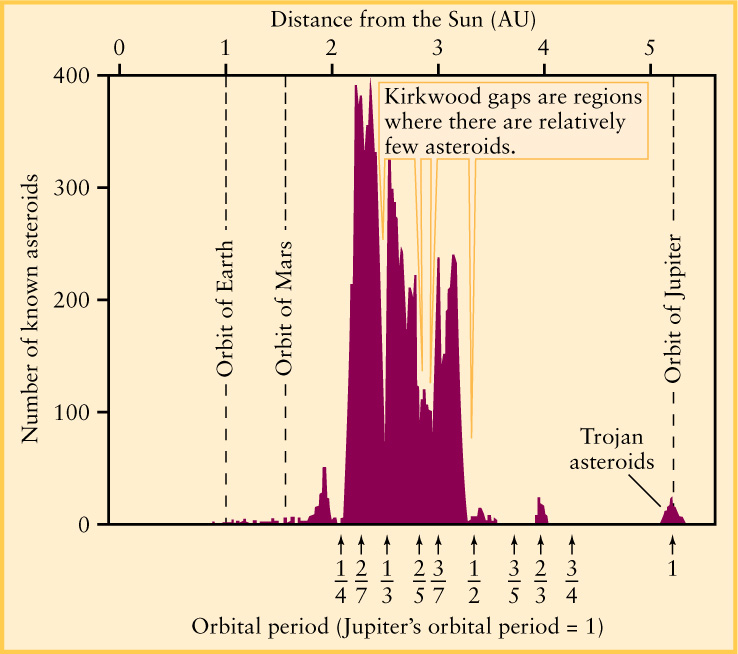15-2 Jupiter’s gravity helped shape the asteroid belt
Where did the asteroid belt come from? Why did asteroids, rather than a planet, form in the solar nebula (see Section 8-5) in the region between Mars and Jupiter? Important insights into these questions come from supercomputer simulations of the formation of the terrestrial planets, like the one depicted in Figure 8-11 but more elaborate.
Jupiter and the Formation of the Asteroid Belt
A typical simulation of the inner solar system starts off with a billion (109) or so planetesimals, each with a mass of 1015 kg or more, so that their combined mass equals that of the terrestrial planets. The computer then follows these planetesimals as they collide and accrete to form the planets. By selecting different speeds and positions for the planetesimals at the start of the simulation, a scientist can study alternative scenarios of the development of the inner solar system.
The asteroids were never part of a larger planet
If the effects of Jupiter’s gravity are not included in a simulation, an Earth-sized planet usually forms in the asteroid belt, giving us five terrestrial planets instead of four. But when Jupiter’s gravity is added, this fifth terrestrial planet is less likely to form. Jupiter’s strong pull “clears out” the asteroid belt by disrupting the orbits of planetesimals in the belt, ejecting most of them from the solar system altogether. As a result, the asteroid belt becomes depleted of planetesimals within about 1 million years, before a planet has a chance to form. The few planetesimals that remain in the simulation—only about 0.1% of those that originally orbited between Mars and Jupiter—become the asteroids that we see today.
Kirkwood Gaps
Jupiter’s gravity continues to influence the asteroid belt down to the present day. The American astronomer Daniel Kirkwood found the first evidence for this in 1867, when he discovered gaps in the asteroid belt. These features, today called Kirkwood gaps, can best be seen in a histogram like Figure 15-4, which shows asteroid orbital periods. The gaps in this histogram show regions where there are relatively few asteroids. Curiously, these gaps occur for asteroid orbits whose periods are simple fractions (such as 1/3, 2/5, 3/7, and 1/2) of Jupiter’s orbital period.

To understand why the Kirkwood gaps exist, imagine an asteroid within the belt that circles the Sun once every 5.93 years, exactly half of Jupiter’s orbital period. On every second trip around the Sun, the asteroid finds itself lined up between Jupiter and the Sun again, always at the same location and with the same orientation. Because of these repeated alignments, called a 2-to-1 orbital resonance, Jupiter’s gravity deflects the asteroid from its original 5.93-year orbit, ultimately ejecting it from the asteroid belt (this is the gap labeled as 1/2 in Figure 15-4). By contrast, for an object not in resonance—whose orbital period does not result in repeated Sun-asteroid-Jupiter alignments—Jupiter’s repeated tugs on the object occur at different locations around the Sun and do not add up in a manner to eventually pull it out of orbit.
Another Kirkwood gap corresponds to an orbital period of 1/3 Jupiter’s period, or 3.95 years (a 3-to-1 orbital resonance). Although not necessarily as strong, additional gaps exist for other simple ratios between the periods of asteroids and Jupiter. Elsewhere in the solar system, similar orbital resonances help clear out the Cassini division in Saturn’s rings (see Section 12-11), and give an outer edge to the Kuiper belt beyond Neptune (see Section 14-10). These are examples of unstable resonances, but under special conditions a resonance can actually be a stabilizing influence (see the clump of asteroids with a period of 2/3 in Figure 15-4).
CONCEPT CHECK 15-3
What prevented a planet from forming where the asteroid belt currently exists, and did this effect eject mass from the region or just keep the existing mass from forming a planet?
Jupiter’s gravity prevented a planet from forming where the asteroid belt currently exists. The planet would have probably been about the size of Earth, but mass was ejected and all the mass in the asteroid belt today could only form a very small object 1500 km in diameter (less than the distance from Los Angeles to Chicago).